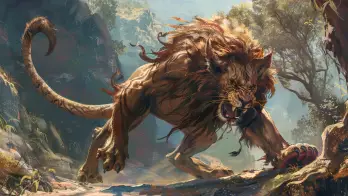According to ancient Irish mythology, this phantom island is a mysterious land perpetually cloaked in dense fog.
Every seven years, the island materializes, but only for a brief 24-hour period, making it accessible to daring sailors who brave the treacherous Atlantic waters.
The Hy Brasil legend
The legend of the island of Brasil has several resemblances to other ancient tales of mythical islands, such as the Island of Mam, the Island of Saint Brendan, or even Atlantis.
According to legend, Brasil was once home to an enigmatic civilization that vanished from the annals of history millennia ago. Still, at the time of its disappearance, it was far more advanced than any other civilization of that era.
Adding to the mystique surrounding this phantom island is that, until the mid-18th century, the island of Brasil was depicted on most naval maps of the Atlantic Ocean.
Nevertheless, superstitious seafarers avoided the region, believing the foggy isle was teeming with flesh-eating monsters.
The existence of a mystifying island, glimpsed once every seven years along Ireland’s west coast, was an accepted truth as early as the 12th century.
Cartographer Angelino Dulcert was the first to sketch an island named Bracile on a navigation map in 1325.
Almost a century later, in 1436, Venetian cartographer Andrea Bianco included a small island on his map, naming it the Island of Brasil.
However, historians believe both cartographers added the island to their maps based purely on rumors and increasingly exaggerated tales about a phantom island.
According to Irish myths and legends that proliferated among local communities, the island was shrouded permanently in dense fog. It was often called the “traveling island” or “floating island.”
As per these Irish fables, the land mass vanished inexplicably whenever people attempted to approach it. However, it became accessible once every seven years. Later, these legends were published in books that documented Irish folklore.
An additional reference to the phantom island appears on a Catalan map from 1480 that labels an island as Illa de Brasil and locates it to the southwest of Ireland.
Expeditions in search of the mysterious island Brasil
In the year 1480, the notable English explorer John Jay Jr. spearheaded the inaugural official mission to validate the existence of the legendary phantom island of Hy Brasil.
Departing from Bristol and heading towards the west coast of Ireland, Jay Jr. returned to Bristol less than a month later, stating that Brasil was no more than a myth.
Subsequent to the original voyage, six more expeditions were launched from Bristol in search of the fabled paradise island.
The last exploration, led by Italian navigator Giovanni Caboto (also known as John Cabot) in 1987, ventured further north in search of Brasil, exploring parts of Labrador, and in the process, carving out a place for himself in the history of geographical discovery.
Cabot returned in 1498, reporting that he had come upon a piece of land off the coast of Ireland and found evidence of the 1480 expedition. He concluded that “the men from Bristol had discovered Hy Brasil.”
Similarly, in 1497, a Spanish diplomat named Pedro de Ayala sent a report to the King of Spain claiming that John Cabot had met with members of the Bristol expedition.
These men, inebriated with alcohol, had shared with Cabot the wonders they had seen on the island but refused to disclose the location of the phantom island.
Pedro de Ayala’s document suggests that John Jay Jr.’s expedition was not a fruitless undertaking, as initially thought, but that the adventurer had, in fact, discovered Hy Brasil. However, the question remains: why did Jay Jr. fabricate his adventure if this was indeed the case?
Johannes Schoner contributed to the Hy Brasil saga in 1515 when he placed Brazil at the southern end of the so-called southern continent, in the polar region, separating it from America by a strait.
An intriguing story about an enchanted island first surfaced in a collection of Irish myths and legends.
The island first became visible to the people of County Cork on July 7, 1678, but it disappeared inexplicably before the locals could mount an expedition to the island.
It resurfaced seven years later, and this cycle continued for almost a century until about 1790, when the island vanished for good.
Upon analyzing Irish legends and maritime maps from that period, several peculiarities about the mysterious island of Hy Brasil can be observed.
The island’s most distinctive characteristic is its circular shape, which is depicted on some maps as a perfect circle. Another unusual feature is the presence of a strange navigable canal that runs from north to south across the island, possibly built by the civilization that once inhabited the island.
Saints Barring and Brendan confirmed the peculiar circular shape and the man-made canal during their visit to the island.
Their accounts reveal how the ship they were traveling in was forced to seek refuge from a sudden storm on a mysterious island shrouded in fog.
The captain ordered an expedition, and Barring, Brendan, and a few other crew members set off along the beach to determine the precise dimensions of the land they had landed on.
The group circumnavigated the island in less than two hours, returning to the point of departure.
Another fascinating account comes from Captain John Nisbet, who, in 1674, explored a part of the island. While sailing towards the west coast of Ireland, the ship was enveloped by a thick fog that drifted for several hours.
When the mist cleared, the crew was horrified to discover that the ship was dangerously close to rocks.
Captain Nisbet miraculously steered the ship through the treacherous waters and stopped near a small bay. Nisbet and four crew members rowed a boat to the beach covered in unusually fine sand.
After spending a day on the island, Captain Nisbet and his crew returned with an impressive treasure trove of gold and silver, which they claimed was given to them by an old man.
This old man appears to be a recurring figure in the mythology surrounding the phantom island of Brasil.
The last reported sighting of the mysterious island was in 1872 by Roderick O’Flaherty, who spent two days there with a man named Morogh O’Ley.
In his book “A Chorographical Description of West or H-Iar Connaught,” O’Flaherty describes his travels on the phantom island and mentions encountering the “mysterious old man.”
There lives Morogh O’Ley. With him, I spent two days on O’Brasil. We traveled and saw the Aran Islands, Golem Head, Irrosbeghill, and other places on the western continent that I did not know existed.
This raises the possibility that the old man who gave Captain Nisbet’s crew their treasure was the same figure O’Flaherty encountered almost two centuries earlier.
A land of eternal youth?
Gerald Griffin, an Irish writer, poet, and playwright, describes the phantom island of Brasil as a blessed, sun-drenched land of eternal youth:
On the ocean that scoops the rocks,
A dark land has appeared,
Men believed it to be a region of sun and rest,
And called it Hy-Brasil, the Blessed Isle.
From year to year, on the edge of the blue ocean,
The beautiful phantom appeared spectacular and vague,
Golden clouds cover the deep where it lay,
And it seemed an Eden far, far away!
According to legend, this enchanted place had miraculous powers that could restore the elderly to youthful vigor, cure the deadliest diseases, and even grant eternal life.
The existence of such a place is a theme found in many cultures, and for the Irish, the phantom island of Brasil was that magical land. The many accounts and testimonials of its miraculous powers further perpetuated the legend.
The myth of the phantom island has been kept alive by various sightings and unusual events.
For example, in 1798, illustrator James Hardiman reported seeing strange lights in the sky over Croagh Patrick, Mayo District, Ireland.
Hundreds of witnesses saw the lights, which then moved over the ocean, revealing several boats moving quickly on the horizon.
These events coincide with the appearance of the phantom island on maps in the past, such as in 1161 when “fantastic ships” docked in the port of Galway.
In fact, the island’s legend may have been perpetrated by a mysterious manuscript at the Museum of History of the Royal Irish Academy that was said to contain treatments for all known diseases.
Experts who studied the encoded text could not decipher its secrets, but it is believed to have been given to a sailor who survived a shipwreck on the phantom island.
The sailor met an old man who treated his wounds and gifted him the mysterious parchment.
The enchanted island’s allure waned in the early 19th century as maritime traffic surged, leading cartographers to question its existence and, consequently, omit it from most navigation maps.
The renowned British cartographer Thomas Jefferys published a series of maps in 1753 depicting the island southwest of Ireland as the “imaginary island of Brasil.”
However, a century later, on a map published in 1865, the phantom island appeared as a mere point marked as “Brazil Rock.”
The Rendlesham incident
The sudden disappearance of a place that once promised unimaginable riches begs the question: how could its legend fade so rapidly from maritime accounts?
However, this phenomenon ended abruptly in 1980 when a strange occurrence, famously known as the “Rendlesham incident,” brought the legend of the island of Brasil back into the discussion.
The Rendlesham incident occurred in 1980 and remains one of history’s most well-documented UFO events.
It happened near Rendlesham Forest in Suffolk, England, a few miles from the twin NATO airbases of Bentwaters and Woodbridge, where the US Air Force stationed its personnel.
On the night of December 26, 1980, the security personnel stationed at the bases observed peculiar lights in the forest, which, upon investigation, led them to a glowing metallic triangular craft with strange symbols on its surface.
The following night, a team of military personnel led by Lt. Col. Charles Halt was dispatched to the site to investigate further.
They discovered more strange lights and what they perceived as a craft hovering in the forest, emitting a pulsating red light.
Despite attempting to approach the unidentified object, it quickly maneuvered through the trees, with soldiers in hot pursuit.
The object eventually led them to a nearby farm where “the animals entered into an inexplicable frenzy,” according to the military report.
Sergeant Jim Penniston, one of the witnesses to the incident, stumbled upon several metallic fragments scattered on the ground.
Upon picking up one of the fragments, he purportedly received a series of numbers and binary codes in his mind.
Penniston recorded the sequence of 1’s and 0’s in a journal, filling up no less than 16 pages. However, the code remained a mystery for almost three decades until binary code expert Joe Luciano deciphered the message.
According to Luciano, the code written by Penniston is a sequence of coordinates that reveal the location of several global monuments, including the Great Pyramid of Giza (Egypt), the Mayan archaeological site of Caracol (Belize), the Nazca plateau, known for the mysterious geoglyphs of an unknown civilization (Peru), and the Temple of Apollo (Greece).
Moreover, the code contains coordinates (52.0942532° N and 13.131269° W) that match those on ancient maritime maps, pinpointing the location of Hy Brasil.
Of particular interest are the mentions of “the year of origin 8100,” which some experts believe represents the “birth year” of an unknown civilization.
At Ancient Theory we only use trusted sources to document our articles. Such relevant sources include authentic documents, newspaper and magazine articles, established authors, or reputable websites.
- Nick Pope, John Burroughs, and Jim Penniston - Encounter in Rendlesham Forest. The Inside Story of the World's Best-Documented UFO Incident. MacMillan Publishers.
- What Happened At The Rendlesham Forest Incident, Britain's Answer To Roswell? history.co.uk. [Source]
- Brasil (mythical island). wikipedia.org. [Source]
- Barbara Freitag - Hy Brasil: the metamorphosis of an island: from cartographic error to Celtic Elysium. Rodopi Publishing, 2013.
- Does a mythical island really exist off the coast of Ireland? irishcentral.com.
- Myths & Legends - The Phantom Island Of Hy-Brasil In Irish Myth And Fable. mythicalireland.com.






